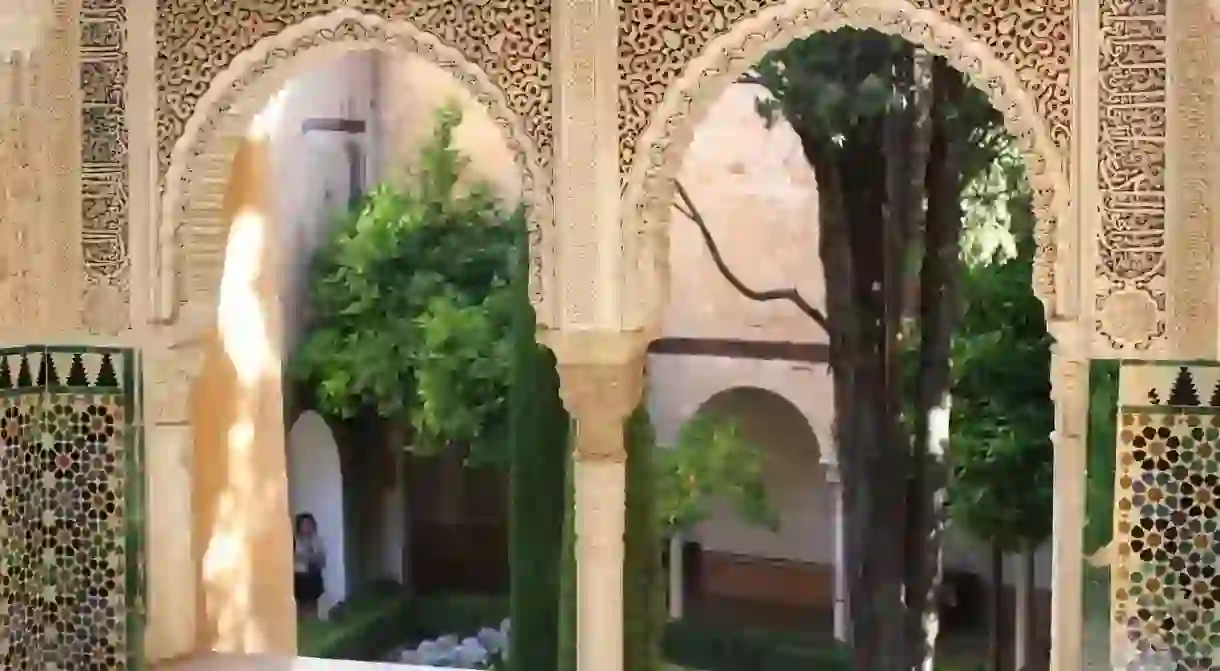The Most Impressive Buildings in Granada, Spain

From the Moorish majesty of the Alhambra to the understated elegance of its former palaces, Granada is full of architectural masterpieces. The city’s most impressive buildings date from its time under Arabic rule and from its Catholic epoch, which began when the Moors were displaced in 1492. Here’s the lowdown on the most jaw-dropping of them all.

Alhambra

One of the region’s most iconic sights is the Alhambra fortress. The greatest surviving relic of Andalusia’s 800 years under Moorish rule, between the 8th and 15th centuries, this sprawling complex sits forbiddingly atop the Darro valley, against a dramatic backdrop provided by the crisp peaks of the Sierra Nevada. Originally dating from the 9th century, the fort and walls were extensively rebuilt in the 1200s by the Moorish ruler of what was then the Emirate of Granada, Mohammed ben Al-Ahmar.
Some of the most impressive aspects of the Ahambra are the Nasrid palaces, built by the Nasrid Kings – the last Moorish rulers of Granada– during the 13th and 14th centuries. These palaces were the governmental heart of the Emirate of Granada and comprise the Mexuar, which contains one of the Alhambra’s most beautiful internal walls; the Comares Palace, which was the official residence of the sultan; and the Lion’s Palace, with an internal courtyard that is one of the most pleasing features of all the palaces.
Palacio de Generalife
Leaving the cool elegance of the Nasrid Palaces, a signposted route takes you through beautiful gardens to the Generalife, or Summer Palace. The exquisite proportions of its gardens provided a cool haven for the sultans during the furnace of Andalusian summers. Narrow paths run alongside delicate flowerbeds and ponds so still that the elegant archways and whitewashed walls, which separated the palace’s vegetable gardens, are perfectly replicated in the water. An external walkway connecting the Generalife’s north and south sides provides a stunning view of the old Arabic neighbourhood of Albaicín; indeed, Albaicín itself is one of the most impressive sights in the city when viewed from the turrets and windows of the Alhambra and Generalife.
Palacio de Dar al-Horra
Granada’s Moorish architecture impresses with its quiet beauty rather than with ostentation or extravagance. This is especially true of this palace, an understated building at the top of Granada’s old Arabic quarter. The Palacio de Dar al-Horra was the residence of Sultana Aixa, mother of Muhammad XII (known as Boabdil in Spanish), the last Moorish King of Granada. In traditional Moorish style, its quarters and rooms are located on three levels around a central courtyard and pool, which provided shade and cool in the summer. Its delicate interiors bring to mind the Alhambra, of which there are stunning views from the roof terrace. Also remaining are parts of what were once extensive gardens and orchards.
The Cathedral
Dominating the historical centre of Granada is the most impressive monument from the city’s Catholic epoch, which began when the Moors were displaced in 1492. Work on this imposing Gothic, Renaissance and Baroque church began in 1518 and, although it took over 180 years and successive architects to build, it’s still not entirely finished: two 80-metre (262-foot) towers were originally planned, but only half of one was ever finished, partly because of a shortage of funds. The cathedral’s towering facade is largely the work of Granadino architect and artist Alonso Cano, who introduced Baroque features when he took over its design in 1667; Cano’s input further contributed to the intriguing mixture of styles that characterise this awesome structure.
Abadia del Sacromonte
High up on the hillside above Granada, off a winding road that leads out of Albaicín into the untamed countryside, is the Abbey of Sacromonte. This beautiful 17th-century structure was built by Archbishop Pedro de Castro y Quiñones on a site that was supposedly the final resting place of Saint Caecilius, a martyr and Granada’s first bishop in the 1st century AD. It was an inspired spot to choose, located so far above the city that the stillness and solitude feel almost like presences. For €4 you can visit some of the interiors and, best of all, the narrow, spooky Holy Caves that are annexed to the abbey.
Charles V Palace
Started in 1526 and abandoned, unfinished, in 1637, this imposing structure had special significance for Charles V, whose grandparents Ferdinand and Isabella wrenched Granada from Moorish rule in 1492. It was partly as a tribute to them, and also to establish a royal residence in Granada, that Charles ordered the construction of this Roman-style palace – a reminder of Catholic supremacy wedged amidst the remains of a great Moorish dynasty. The highest colonnade of its beautiful circular courtyard was finished in 1619, but the roof was never added: standing in its centre, you look straight up into the deep, hard blue of an Andalucian sky. Nowadays, the Charles V palace is home to Granada’s Museum of Fine Arts, which can be visited for free.
Did you know – Culture Trip now does bookable, small-group trips? Pick from authentic, immersive Epic Trips, compact and action-packed Mini Trips and sparkling, expansive Sailing Trips.













